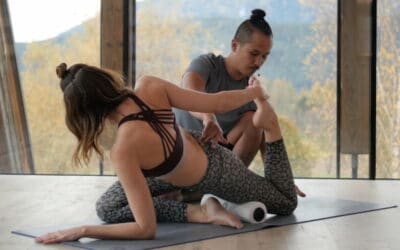The yoga pose Half Moon, or Ardha Chandrasana in Sanskrit, is quite a challenging yoga asana. Not only does it require core strength and hip flexibility, it also challenges your coordination and your sense of balance.
For beginners, this pose can be the peak pose in a playful yoga class. For more advanced students, it’s the invitation to go into Sugarcane pose (Ardha Chandra Chapasana). Whether newbie or pro, warming up for, and sequencing around, this asana is a fun way to improve your focus and coordination and to find your balance – both physically and mentally.
Find out all you need to know about Half Moon pose:
1. How to Do Ardha Chandrasana (Half Moon)?
1. Start in Warrior 2.
2. Place the back hand onto the back hip. The front leg is going to be your standing leg.
3. Take the front fingertips to the ground in a diagonal line out in front of the standing leg. The further the hand is in the front, the easier it gets.
4. Step the back foot a few centimetres forward. You can even drag it forward.
5. Keep the front knee bent and shift your bodyweight forward into your front leg and hand.
6. Once you feel the bodyweight is shifted forward, lift the back leg by using the strength of the outer back hip.
7. Let the pelvis remain open like in Warrior 2 and turn the chest toward the sky.
8. Flex the back foot (i.e. the lifted one) and engage it by pressing the heel away from you.
9. Keep the standing leg slightly bent but lean back until you feel the heel pushing into the ground. This will also engage the buttocks muscles more.
10. Fix your gaze at one point in front of you (called Drishti). This will help you balance.
11. To come out of the pose, bend the standing leg deeper and tap the back foot onto the ground.
12. Engage your core to rise up and return to Warrior 2.
Now it’s time to practice. Let TINT Instructor Matt Giordano explain you in a short video how to do Ardha Chandrasana. In his workshop The Essentials of Yoga, he teaches you all the basics of breathing and the various poses so you will have a good foundation for your practice.
Let Matt Giordano explain you how to do Half Moon pose.
“Yoga is not for the flexible, it’s for the willing.”
2. What Is Your Body Doing in Half Moon Pose?
2.1. What Are the Joints Doing?
In Ardha Chandrasana, the spine is neutral with a slight rotation in the chest to orient to the side. If the head is facing upwards, there’s also rotation in the neck.
In the upper body, the shoulders are abducted and externally rotated while the forearms remain neutral.
When it comes to the lower body, we have to look at the standing leg and the lifted leg separately. The sacroiliac (SI) joint of the standing leg is in nutation (i.e. the top of the sacrum moves forward while the bottom moves back). The hip is flexed and abducted while the knee is neutrally extended. There’s dorsiflexion in the ankle.
In the lifted leg, the SI joint is in counternutation, i.e. the top of the sacrum tilts back and the bottom tips forward. The hip is extended and adducted and the knee is also neutrally extended. The ankle is in dorsiflexion.
2.2. Which Muscles Are Engaged?
In this balancing pose, the spinal extensors and flexors are alternating between concentric and eccentric contraction to maintain the neutral alignment of the spine.
The internal obliques of the upward-facing side and the external obliques of the downward-facing side of the torso are contracting concentrically.
In order to be able to rotate the head toward the ceiling, the muscles in the neck and the back of the head need to contract concentrically as well. The spinal muscles of the downward-facing side have to contract eccentrically to resist the side-bending into gravity.
As regards the upper limbs, the serratus anterior is responsible for the abduction of the scapula. The rotator cuff muscles as well as the biceps and the deltoid help to stabilize and abduct the shoulder joint.
When in comes to the standing leg, the gluteus medius and minimus effect the abduction of the hip. Articularis genu and vastii extend the knee. The gluteus maximus and piriformis contract eccentrically to abduct and flex the hip without the hip collapsing into gravity. The hamstrings and the hip joint support this action. The intrinsic and extrinsic muscles of the foot help to maintain the integrity of the foot.
In the lifted leg, the hamstrings and the hip muscles contract concentrically to extend the hip. The articularis genu and vastii extend the knee. The gluteus medius and minimus work to adduct the hip, while the piriformis maintains the hip extension during the adduction.
For more tips on proper alignment in some of the most common yoga poses, check out our free asana ebook. You’ll find step-by-step instructions, alignment quick-fixes and sequencing tips. Simply download it here and use it as your reference guide on the go.
3. What Should You Pay Attention to in Ardha Chandrasana?
Balance is not the only difficulty in Half Moon yoga pose. There are some other things you should pay attention to when practicing Ardha Chandrasana.
1. Avoid your chest rotating toward the floor. This often happens when you try too hard to reach the floor with your hand. To overcome this, place a block under the front hand for some extra height. This will allow you to open the chest toward the ceiling easier.
2. Avoid locking your standing knee. A joint lock in the knee does not only bear the risk of injury, it also decreases your flexibility in the hip joint. As a consequence, you will not be able to keep the pelvis open.
3. Keep the lifted leg in one line with your hip. Often, the tendency is to either lift it too high or push it too far back behind you.
4. Avoid straining the neck too much. If you have any issues with the neck, turn your head to face the floor or in front rather than looking up to the sky.
5. Be careful if you suffer from any hip injuries or issues such as arthritis. Since you place a lot of weight on your hip joint, this can cause extra stress.

Pay attention to these 5 things in Half Moon yoga pose.
4. What Are Possible Half Moon Pose Variations?
4.1. Adapt Half Moon Pose for Beginners
Ardha Chandrasana is definitely one of the more challenging yoga balance poses. So be patient with yourself as you make your way into the pose. Here are a few tips that will make this yoga pose also accessible to beginners.
1. Use a Block
If it’s difficult for you to touch the floor with your front hand or fingertips, use a block for support. Play with the different heights of the block, i.e. by starting at the highest height and, with increasing balance and stability, lower it down to its middle height, and then – finally – to its lowest height.
2. Lean Against a Wall
If balancing on one leg is challenging, there’s nothing wrong with practicing Half Moon pose near a wall for starters. Support your lifted foot on the wall. This also helps you to get a feeling for bringing the leg parallel to the floor.
3. Place the Foot Against a Wall
You can also use the wall in a different way. Set yourself up by sitting in Dandasana with the feet against the wall. Mark the position of your hips on the yoga mat (e.g. with a block). Come up to stand facing away from the wall. Place your standing leg at the marked position. When you now lift the other leg, you can press the sole of the foot into the wall. The pressure of the raised heel against the wall will help you maintain your balance.
To adjust your position, you can place both hands on the floor and wiggle your front foot forward or backward until you have the perfect position to comfortably rest your back foot against the wall.
Let your toes face the floor at the beginning. With an exhalation, you rotate the chest upward and simultaneously turn the back leg and until the inner edge of the foot is parallel to the floor.
You can rest the hand of the lifted-leg side on the upper hip or extend it toward the sky. The front hand can be on the ground or placed on a yoga block at the height you need to feel stable.
4. Get a Partner
A fellow yogi can also support you in Half Moon yoga pose. Your partner should stand behind you in an angle so that they face your head. In this way, you can use your partner as kind of a wall and support your buttocks against your partner’s hip. At the same time, they can use their hands to support your lower hip without pulling it up.
This will give you the stability to rotate your chest toward the sky. Maybe, your fellow yogi can even gently hold your arm as you straighten it upward.
4.2. Challenge Yourself in Ardha Chandrasana
If you’re an advanced practitioner already and want to challenge yourself in Half Moon, work on holding this yoga pose as long as possible – maybe even up to 30 seconds.
1. Lift the Bottom Hand
Once you feel stable in Ardha Chandrasana, you can gradually take the weight out of your bottom hand until the tip of the middle finger is the only thing touching the floor. As a next step, try to even hover the hand above the ground. However, don’t let this comprise the solid alignment of the rest of the pose.
2. Look Up to the Sky
If you feel stable, you can straighten the top arm up in the air so that it is perpendicular to the ground. Press the hand actively into an imaginary wall in front of you. If you’re able to maintain your balance, slowly rotate your head so that your gaze follows your top hand.
3. Sugarcane Pose (Ardha Chandra Chapasana)
This is an even more advanced variation of Half Moon pose. To do Sugarcane pose, or Ardha Chandra Chapasana as it’s called in Sanskrit, bend your lifted leg so that the heel moves toward the buttocks. Reach back with your top hand and clasp your ankle. Push the foot into the hand and vice versa to come into a gentle backbend.

Sugarcane pose is a more challenging Half Moon variation: Photo: TINT Instructor Ami Norton.
If you’re looking for guidance in other yoga poses, check out our free yoga asana eBook that takes you through ten of the most commonly practiced yoga poses.
5. What Are the Benefits of Half Moon Pose?
The yoga pose Half Moon, or Ardha Chandrasana, is a great pose to improve your balance and focus as well as core stability. This will benefit you in a variety of other sports as wel as your daily activities, especially as you get older.
Apart from that, it also strengthens the entire body, especially the thighs, ankles and feet. It also is a great stretch for the hamstrings. So, if you’re a runner or cyclist with tight hamstrings, the yoga pose Half Moon can be very beneficial for you.
This pose also helps you open your chest and shoulders.
Due to the challenge it provides for your coordination and sense of balance, you will also find that it relieves stress and helps you clear your mind.
Ready to practice?
Now it’s time that you roll out your yoga mat and start challenging your balance with Half Moon and other balancing yoga poses. Set the foundations with Matt Giordano’s class Focus and let Hie Kim take you through the Anatomy of Balance in his beginner-friendly balancing yoga class.
Being balanced and steady is essential for having a solid foundation. Balance your first Chakra to find this groundation with Faith Hunter in her 1st Chakra Practice.
If you’re up for more challenging Half Moon variations and other balancing poses, Sianna Sherman’s yoga sequence Way of the Warrior is for you. You can also work on Strength & Balance with Alexey Gaevskij or try an entire yoga sequence without using your hands in Ami Norton’s Hands-Free Flow. These yoga classes will definitely help you find your balance in Half Moon pose!
Header picture: TINT teacher Manuela Neddermayer













